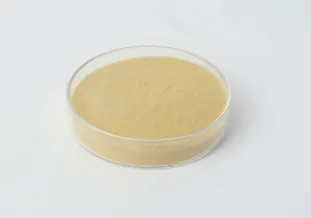
Fréttir
feb . 24, 2025 14:33 Aftur á lista
Diabetic Wound Care: Amino Acid Polymer Hydrogels
Diabetic wounds, especially those on the feet and legs, can be slow to heal due to poor circulation and high blood sugar levels. The innovative use of amino acid polymer hydrogels is transforming how we approach the treatment of these stubborn wounds. This breakthrough technology helps to speed up healing, reduce infection risk, and promote overall skin regeneration. By leveraging the natural properties of amino acid polymers, these hydrogels create a moist, healing environment that facilitates rapid tissue repair, making them an essential tool for diabetic wound care.

Polymer of an Amino Acid: The Foundation of Healing Hydrogels
The polymer of an amino acid plays a crucial role in wound healing by forming a flexible, protective barrier over the affected area. This polymer is derived from natural amino acids, which are the building blocks of proteins. When these amino acids form polymers, they have the ability to mimic the body's natural healing processes. This makes amino acid polymers ideal for diabetic wound care, as they encourage tissue regeneration, reduce inflammation, and keep the wound moist, preventing scarring and infection. The polymer of an amino acid helps to create a gel-like structure that supports healing by maintaining an optimal environment for skin cells to regenerate.
Properties of Amino Acid Polymer in Wound Care
The properties of amino acid polymer are incredibly beneficial when applied to diabetic wound care. These polymers are biocompatible, meaning they won't cause irritation or adverse reactions on the skin. They are also hydrophilic, allowing them to absorb water and create a moisture-rich environment for the wound, which is key to healing. Additionally, amino acid polymers can enhance the delivery of growth factors and other healing agents directly to the site of injury. Their ability to retain moisture helps to speed up cell regeneration, promoting the formation of healthy tissue while preventing the wound from drying out. The flexibility and adaptability of amino acid polymers ensure that they stay in place without irritating the surrounding skin, providing long-lasting support for diabetic wounds.
Protein Amino Acid Polymer: Enhancing Tissue Regeneration
The protein amino acid polymer is a critical element in the development of advanced wound care treatments. Proteins are made up of chains of amino acids, and when these amino acids form polymers, they create strong yet flexible structures that can promote tissue repair. In diabetic wound care, the protein amino acid polymer encourages the regeneration of skin cells by providing the necessary building blocks for new tissue formation. These polymers enhance the body's natural ability to repair itself by supporting collagen production and cellular growth. By combining the properties of protein amino acid polymers, the healing process is accelerated, reducing recovery time and the likelihood of complications such as infection.
Protein as a Polymer of Amino Acid: The Key to Diabetic Wound Healing
Protein as a polymer of amino acid is a game-changer in diabetic wound care because it takes advantage of the body’s own healing mechanisms. By using these protein-based polymers, we can replicate the natural processes that occur during wound healing. The protein polymer of amino acid functions as a scaffold, promoting the growth of new tissue and accelerating the closure of wounds. These proteins not only provide structural support for damaged tissues but also help to regulate the inflammatory response, which is crucial in diabetic patients who may struggle with chronic inflammation. With the addition of protein as a polymer of amino acid, diabetic wounds are able to heal faster and with less risk of complications.
Why Choose Amino Acid Polymer Hydrogels for Diabetic Wound Care?
If you're looking for an effective, advanced solution for diabetic wound care, our amino acid polymer hydrogels are designed to provide maximum healing benefits. With the combined power of protein amino acid polymers and amino acid polymer properties, these hydrogels offer unparalleled support for diabetic wounds, creating a moist, nurturing environment for faster healing. The gel forms a protective layer that enhances tissue regeneration while preventing infection. Choose our hydrogels for a more efficient, natural approach to wound healing and experience the benefits of amino acid polymer hydrogels. Visit our website today and invest in the future of diabetic wound care.
-
Why Iminodisuccinic Acid Salts Are Revolutionizing Industrial Cleaning
FréttirJul.28,2025
-
The Role of Polyaspartic Acid Salts in Sustainable Agriculture
FréttirJul.28,2025
-
Polyaspartic Acid in Agriculture: A Revolutionary Solution for Sustainable Farming
FréttirJul.28,2025
-
Iron Chelating Agents: Understanding Their Role in Treating Iron Overload Disorders
FréttirJul.28,2025
-
Innovations in Gypsum retarder Retarders: From Chemical to Organic Solutions
FréttirJul.28,2025
-
How Polyaspartic Acid Salts Are Replacing Toxic Industrial Chemicals
FréttirJul.28,2025
